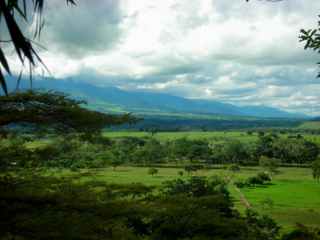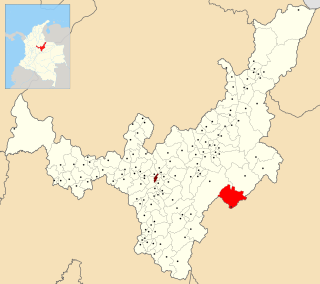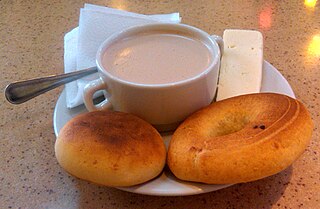Casanare Province was one of the provinces of Gran Colombia.
Contents

Casanare Province was one of the provinces of Gran Colombia.

It belonged to the Boyacá Department, which was created in 1824.
The capital was Moreno, now called Paz de Ariporo. [1]
Watercolors painted in 1856 by Manuel María Paz provide early depictions of the Guahibo and Saliba people in Casanare Province. [2] [3]

Cartago is a city in southwestern Colombia, about 187 miles west of Bogotá. It is in the extreme northern portion of the Valle del Cauca Department. It is located very close to the city of Pereira, about a 20-minute drive. It is the fourth largest city in Valle after Cali, Palmira, and Tuluá. In 2019, it had a population of approximately 135,000 inhabitants.

Arauca Department is a department of Eastern Colombia located in the extreme north of the Orinoco Basin of Colombia, bordering Venezuela. The southern boundary of Arauca is formed by the Casanare and Meta Rivers, separating Arauca from the departments of Casanare and Vichada. To the west, Arauca borders the department of Boyacá. The Caño Limón oil fields located within Arauca account for almost a third of the Colombian oil output. Its capital is the town of Arauca.

Arauca is a municipality and capital city of the Arauca Department of Colombia. Its full name is Villa de Santa Bárbara de Arauca, it is located at N 07° 05′ 25″ - W 70° 45′ 42″. The Municipality of Arauca has a total population of 85,585.

Quibdó is the capital city of Chocó Department, in Western Colombia, and is located on the Atrato River. The municipality of Quibdó has an area of 3,337.5 km² and a population of 129,237, predominantly Afro Colombian and Zambo Colombians.

The Llanos is a vast tropical grassland plain situated to the east of the Andes in Colombia and Venezuela, in northwestern South America. It is an ecoregion of the tropical and subtropical grasslands, savannas, and shrublands biome.

The Meta River is a major left tributary of the Orinoco River in eastern Colombia and southern Venezuela, South America. The Meta originates in the Eastern Ranges of the Andes and flows through the Meta Department, Colombia as the confluence of the Humea, Guatiquía and Guayuriba rivers. It flows east-northeastward across the Llanos Orientales of Colombia following the direction of the Meta Fault. The Meta forms the northern boundary of Vichada Department, first with Casanare Department, then with Arauca Department, and finally with Venezuela, down to Puerto Carreño where it flows into the Orinoco.

The Nevado del Quindío is an inactive volcano located in the Central Cordillera of the Andes in central Colombia. The summit marks the tripoint of the departments of Risaralda, Quindío and Tolima, and is also the highest point of the departments of Risaralda and Quindío. The mountain is one of the highest peaks in the Los Nevados National Natural Park, which is a wildlife sanctuary. There are no historical records of any eruption. The andesitic volcano is located on top of the Palestina Fault.

The Guahibo people are an indigenous people native to the Llanos or savanna plains in eastern Colombia and in southern Venezuela near the Colombian border. Their population was estimated at 23,772 people in 1998.

Lloró is a municipality and town in the Chocó Department, Colombia. It claims the second world record for highest average annual precipitation with 12,717 mm (501 in), after López de Micay, which holds an also disputed record with 12,892.4 mm (508 in). The official record is held by Mawsynram, India. The rainfall data was measured in its Agricultural Farm, managed by the University of Bogotá, between 1952 and 1989. If accurate, that would make it the wettest place in the world. The town is named for Gioró, a pre-Columbian indigenous chief.

Nóvita is a municipality and town in the Chocó Department, Colombia.

An 1853 watercolor by Manuel María Paz showing a house in Sipí, built on a raised platform with a notched treetrunk for steps, is held by the National Library of Colombia.

Paz de Ariporo is a town and municipality in the Department of Casanare, Colombia.

Güicán is a town and municipality in the Colombian Department of Boyacá. It is close to the national natural park El Cocuy National Park.

Pajarito is a town and municipality in the La Libertad Province, part of the Colombian department of Boyacá. The municipality, situated in the southeast of the department borders Labranzagrande and Aquitania of the department of Boyacá and Yopal, Recetor and Aguazul of the department of Casanare. The urban centre is located at a distance of 147 kilometres (91 mi) from the department capital Tunja at an altitude of 800 metres (2,600 ft) in a tight valley, not allowing much expansion of the urban area. The centre is experiencing periodic landslides.

Puracé is a town and municipality in the Cauca Department, Colombia.

Pan de yuca is a type of bread made of cassava starch and cheese typical of western Ecuador and southern Colombia
Saliba is an indigenous language of Eastern Colombia and Venezuela. Saliba was used by Jesuit missionaries in the 17th century to communicate with indigenous peoples of the Meta, Orinoco, and Vichada valleys. An 1856 watercolor by Manuel María Paz is an early depiction of the Saliva people in Casanare Province.

The Patía River is a river in southwestern Colombia. It flows over 400 kilometres (250 mi) to drain into the Pacific Ocean north of Tumaco. The Patía River is the longest river on the Colombian Pacific Coast. The last 90 kilometres (56 mi) is navigable by boat.

The Tapaje River is a river which flows through Colombia. It empties into the Pacific Ocean.

Popayán Province was first a Spanish jurisdiction under the Royal Audience of Quito, and after the independence one of the provinces of the Cauca Department, later becoming the Republic of New Granada.